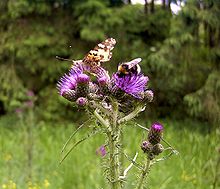- Cirsium palustre
-
Cirsium palustre 
Scientific classification Kingdom: Plantae (unranked): Angiosperms (unranked): Eudicots (unranked): Asterids Order: Asterales Family: Asteraceae Tribe: Cynareae Genus: Cirsium Species: C. palustre Binomial name Cirsium palustre
(L.) Scop.Cirsium palustre, the marsh thistle or European swamp thistle, is a herbaceous biennial (or often perennial) species of the genus Cirsium.[1] It is a tall thistle which reaches up to 2 metres (7 ft) in height. The strong stems have few branches and are covered in small spines. In its first year the plant grows as a dense rosette, at first with narrow, entire leaves with spiny, dark purple edges; later, larger leaves are lobed. In the subsequent years the plant grows a tall, straight stem, the tip of which branches repeatedly, bearing a candelabra of dark purple flowers, 10–20 millimetres (0.4–0.8 in) with purple-tipped bracts. In the northern hemisphere these are produced from June to September. The flowers are occasionally white, in which case the purple edges to the leaves are absent. It is native to Europe where it is particularly common on damp ground such as marshes, wet fields, moorland and beside streams. In North America it is an introduced species that has become invasive.
Ecology
C. palustre is broadly distributed throughout northern Europe and eastward to central Asia. This thistle's occurrence is linked to the spread of human agriculture from the mid-Holocene era or before.[2] It is a constant plant of several fen-meadow plant associations, including the Juncus subnodulosus-Cirsium palustre fen-meadow.[2]
References
- ^ J. S. Rodwell. 1998. British Plant Communities, p. 227
- ^ a b C. Michael Hogan. 2009. Marsh Thistle: Cirsium palustre, GlobalTwitcher.com, ed. N. Strömberg

This Cynareae article is a stub. You can help Wikipedia by expanding it.

